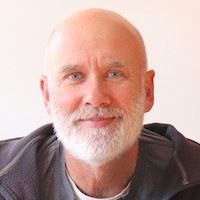12+ In 2019, approaching the 30th anniversary of the fall of the Berlin Wall, I found a timely book in a secondhand bookshop: The Berlin Wall, 13 August 1961 – 9 November 1989 by Frederick Taylor. The book inspired me to write about my two contrasting visits to Berlin as a backpacker in 1987 and 1995.
Taylor tells the story of the Berlin Wall, from its construction to becoming the starkest symbol of the Cold War, the escape attempts and repercussions, and its eventual fall, heralding the end of a divided Germany. The book is also a history of the "marsh town" that became Berlin. And in his afterword, Taylor reflects on the Wall, city and country post-German reunification:
For anyone who knew the city when the Wall cast its pall across Berlin, nothing can beat the pleasure of being able to stroll through the Brandenburg Gate and across the Pariser Platz, maybe heading for … one of the boulevard cafes on Unter den Linden. And nothing is sweeter than the awareness that, compared with twenty years ago, the greatest danger you run when taking these few unhurried paces is of being knocked into by an over-enthusiastic bicycle courier, not cut in half by a burst of automatic fire.
After reading Taylor's book, I dug out my old travel journals and a souvenir book from Checkpoint Charlie, "It Happened At the Wall". And the Ostmark note I'd smuggled out of East Berlin in 1987.
However, as I've observed elsewhere on Tall And True, life and other writing often get in the way of my plans. The 30th anniversary of the fall of the Wall on 9 November 2019 came and went. And then, in 2020, we had another distraction, COVID-19.
Tunnel 29 by Helena Merriman
In August 2021, I heard an ABC Radio Nightlife episode of This Week in History, marking the 60th anniversary of the building of the Berlin Wall. The host interviewed BBC current affairs journalist and broadcaster Helena Merriman about the history of West and East Berlin and her new book, Tunnel 29 – Love, Espionage and Betrayal: The True Story of an Extraordinary Escape Beneath the Berlin Wall.
Afterwards, I bought the audiobook version of Tunnel 29, narrated by Merriman. Rather than a broad history of Berlin and the Wall, Merriman focuses on Joachim Rudolph, an East German escapee who dug a tunnel with a team of university students to rescue twenty-nine men, women and children from East Berlin. And all the while, they risked detection by the ruthless East German security apparatus, the Stasi, and infiltration by spies.
Listening to Tunnel 29 spurred me to return to writing about my visits to Berlin. If not to celebrate the 30th anniversary of the Wall's fall, then to mark the 60th anniversary of its construction.
Divided Berlin, 1987
In 1987, my then-girlfriend (now wife) and I left Australia to travel and live overseas for two years (we stayed away for nine years). The first part of our journey included two months of backpacking and Eurailing around Europe.
When we set off, I started recording a journal of our adventures. It's a habit I've kept up ever since, with a boxful of travel journals and daily diaries (the latter for the more mundane parts of life) in a loft cupboard. The entries for this travel piece are from my 1987 and 1995 journals.
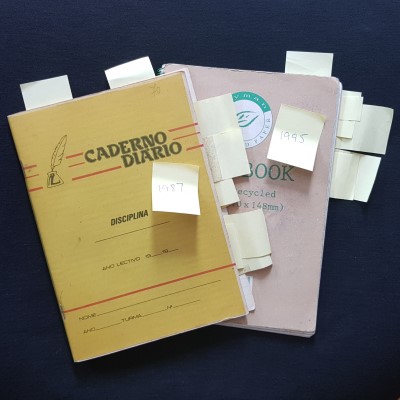
Sidenote: I've corrected typos and inaccuracies in my journal extracts and left out names and boring backpacker bits (typically, grizzles about this or that). In addition, I've added Wikipedia links for the key sights and events mentioned in the entries. And I've included images from Pixabay because they look much better than my photos. (For instance, of the Berliner Dom!)
23 June 1987 - Border Campground
We made our way from the centre of Helmsted to a campground close to the East German border, where we met five Aussie guys travelling in a Bedford van. I asked if we could hitch a lift with them to Berlin tomorrow and was relieved when they replied, "No worries, mate."
24 June 1987 - Van to Berlin
Our first impressions of the Deutsche Demokratische Republik (DDR) were confusing as we struggled to follow transit lane directions at the border. The van deputised me to show our wad of passports. Thankfully, the border guards were friendly, with one joking about how little I resembled my fresh-faced passport photo.
Sidenote: I studied conversational German for a year before leaving Australia to help us communicate in Germanic-speaking countries. But sign language proved more effective than "Zwei bier, bitte" at border crossings.
The East German Trabants on the transit road to Berlin looked dated. And the police cars were almost comical. The Aussie guys had fixed an Australian flag on the rear doors of the van. Locals stared at us as we drove past, and one gave us a two-fingered vee sign, either "peace" or "up yours" — we weren't sure which.
The fields beside the transit road seemed full of cabbages, tended to by older farmhands. There was a church steeple in a village in the distance. And yet, I thought communist countries had banned religion.
We had no "lane directions" or passport photo problems crossing from the DDR into West Berlin and were soon in the city centre, where we said goodbye to the Aussie guys and headed for the Zoologischer Garten Bahnhof.
West Berlin presents as a modern commercial city with tall buildings and a fast pace of life. And as we walked around, I found it hard to believe the Berlin Wall was close by — we could have been in the streets of Sydney.
We stopped for lunch outside the Berlin Zoo. Nearby were the ruins of Kaiser-Wilhelm-Gedächtniskirche, a stark reminder of World War II among the flashy modern buildings. After lunch, we climbed the Siegessäule (Victory Column), from where we could see where West Berlin ended, and the East began.
Through a telescope, I recognised the backdrop of Ronald Reagan's "Tear down this wall" speech from two weeks ago, the Brandenburg Gate. We knew the Wall was in front of this site, so we descended Siegessäule and headed down the broad Straße des 17. Juni towards it.
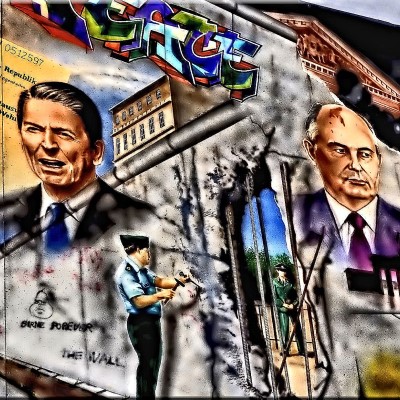 Image by Andre Drechsel from Pixabay
Image by Andre Drechsel from Pixabay
The first thing that struck me about the Berlin Wall was the graffiti covering it. And this became even more striking after we'd stepped onto a viewing platform to look into Ost Berlin, where the Wall is spotless.
In the West, you can walk up and touch the Wall (and graffiti it). While in the East, there's a wide clear strip of no man's land between the outer and inner walls. And guards will shoot you for venturing into this area, which includes the Brandenburg Gate.
The Wall is lower in front of the viewing platform but rises steeply, sheer and impenetrable on either side. It felt strange, standing in the West, staring into the East. And I wondered what the few people (mostly soldiers) we saw on the other side thought of us peering over the Wall.
We left the viewing platform and followed the Wall to the Reichstag building, with a photographic history of modern (West) Germany on display. And then, we headed for an S-Bahn station to catch a train to an outer suburban campground.
Sidenote: Other than the photographic display, I recorded nothing about the Reichstag and its historical significance. It reflects the priorities of a backpacker that my journal jumped to the routine task of finding accommodation.
The campground was further from the city centre than we'd expected — we hadn't realised West Berlin was so "big". And it was expensive, but then as we'd learned, that's the norm for Berlin. We cooked dinner and chatted with a Canadian couple, who had also driven across the border in a campervan today (without problems).
LOVE WRITING NONFICTION?
Share and showcase your nonfiction and other writing — fiction and reviews — as a Guest Writer on Tall And True.
25 June 1987 - East Berlin Daytrip
We rose early for the S-Bahn train to the station near Checkpoint Charlie. On the walk from the station to the border, we passed a busy construction zone with rows of new apartment blocks. Over the Wall, we saw similar blocks going up in the East. Seeing parallel building works in vastly different political and economic systems seemed odd.
Our passage through Checkpoint Charlie to East Berlin was smooth. Although an East German border guard was intrigued by the sunflower seeds we had in our daypacks for snacks.
At first, I couldn't tell the difference between the two Berlins — let alone comprehend I'd crossed into the Eastern Bloc. Yes, grey apartment towers flanked the streets heading towards the town centre. But I've seen similar sights in parts of Sydney. Except, the Ostberlin apartment car parks were full of Trabants instead of Aussie Holdens!
In the centre, major restoration works appeared underway on grand old buildings. Near Marx-Engels Platz, we stopped to photograph the impressive Berliner Dom with its tree-lined forecourt. And then we moved on to the Fernsehturm (Television Tower), which stands like "Big Brother" looking down on Ostberliners.
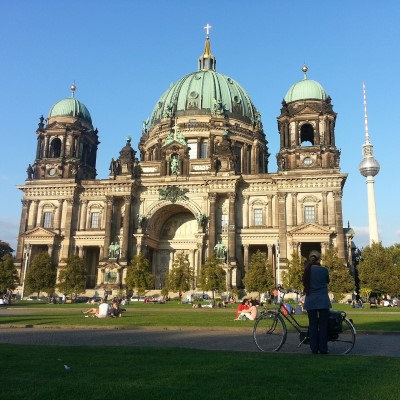 Image by monica_jim0 from Pixabay
Image by monica_jim0 from Pixabay
At the border crossing, we'd both had to change 20 Deutsche Marks for 20 Ostmarks (the real exchange rate is closer to ten to one). And as we had to spend all Ostmarks before returning to the West, we visited a "markthalle" (market hall) to stock up on supplies.
Inside the market, we soon noticed the difference between our economic system and the Eastern Bloc. Everyone shopper queued for a shopping trolley, no matter what item they wanted to purchase. The trolleys were small (almost toy-like), the shelves were sparse, and prices were much lower than in the West. The only exceptions were milk products, like our backpacker staple, cheese.
We queued to buy a few items and then went outside to the open market to queue for lunch. Eating at a table surrounded by Ostberliners, I reflected on how communism (or socialism) may suit some people. And that some Australians want the state to look after them, too. But at what price?
After lunch, we looked for other ways to spend our Ostmarks. I baulked at queueing to browse at a bookshop, so we visited the Nationalgalerie (National Gallery). It had a fine display of anti-war paintings, but the entrance fee was minimal.
We returned to the bookshop, queueing for the mandatory shopping basket before we entered. Unfortunately, most of the books were socialist propaganda. One example was a book on modern English history, with a damning treatment of Margaret Thatcher.
Sidenote: Having lived in Thatcher's Britain from 1987 to 1990, I wish I'd bought the book.
We took a break from spending Ostmarks and walked to the Brandenburg Gate to look at it from the East. A few soldiers (perhaps Russians?) were posing for photos with the graffiti-free Berlin Wall in the background. And over the top of the Wall, we could see people on the viewing platform where we'd stood yesterday.
It occurred to me they might be wondering if I was an Ostberliner. And to convince them one way or the other, I waved hello.
We spent the last of our Ostmarks at a cafe. I had a stein of beer for 1.5 Ostmarks (recalling the 10 to 1 exchange rate), and then we had coffee and cakes. A young guy sat at a nearby table, reading a book. I felt sorry for him when we left. Assuming he's an Ostberliner, he can't leave the East. But I also felt happy and relieved we were about to head back to the West.
The border crossing was straightforward, and I smuggled across a fünf Ostmark note (which felt like my "Spy Who Came in from the Cold" moment). We bought a souvenir book from the Checkpoint Charlie Museum (without queueing for a shopping basket), then caught the S-Bahn back to our campground.
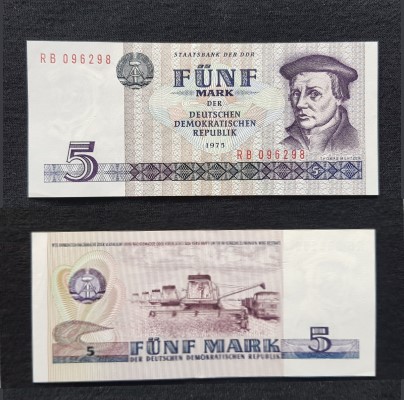
That night we discussed the pros and cons of communism with the Canadian campers and an American couple who joined our table. And that's the benefit of our system. We can debate politics in the open, while those in communist states must tow the party line (like the Ostberliner reading the book at the cafe).
I prefer our way of life. But I know some living in western democracies could do with the social services and security of the communist/socialist states. Again, at what price?
26 June 1987 - Auf Wiedersehen Berlin
We hitched a lift with the Canadian campers from Berlin to West Germany. There was a delay at the transit road border checkpoint, packed with vehicles waiting to cross. Finally, we got through, and after two hours of driving with only one wrong turn (signalled by a thumb-back from a truck driver), we arrived at the DDR-Bundesrepublik border.
In contrast to when we entered the DDR with the Aussies, the East German border guards went over the Canadian couples' van methodically, insisting they open every possible hiding space. I also saw guards checking loads on trucks and inspecting under vehicles with extension-arm mirrors.
I realised they were not looking for drugs or other contraband but for stowaway escapees from the East. Like East Berlin behind the Wall, the communist country was a jail.
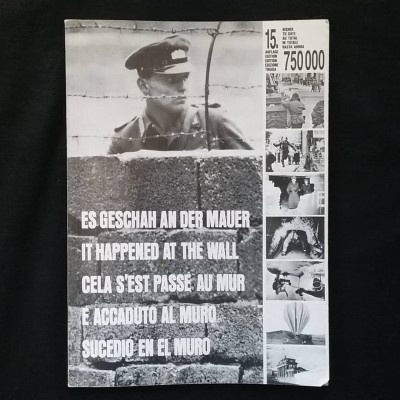
Reunified Berlin 1995
After living and working in England from 1987, my wife and I returned to Australia in 1995, overland. As I wrote in a Tall And True blog post, Michael Palin's 1991 BBC series, Pole to Pole, inspired our journey and route.
First, we headed north to Finland to visit a friend. Then we turned south, travelling by ferry, train, bus, taxi, truck and bicycle, like Palin, for the next eight months to Zimbabwe. And along the way, we revisited Berlin, as I recorded in my travel journal.
24 July 1995 - Where's the Wall?
We had a good overnight train journey from Krakow to Berlin, stretching our legs and snatching sleep between ticket checks and the Polish-German border crossing.
The train arrived early in Berlin. But we lost our morning booking for the evening's onward overnight journey to Prague, searching for tourist information for a map and Amex to get Deutsche Marks for the day.
Finally, set off on S-Bahn to Berlin Zoo. Unfortunately, we couldn't work out the direction to the site of the Wall and blundered about in circles, lost (and cross!). Until we spied the gold-topped Siegessaule column, which we'd climbed in 1987, and knew that a street led from it to the Brandenburg Gate.
The area around the Brandenburg Gate was vastly different from how we remembered it. In 1987, the graffiti-covered Berlin Wall separated us from the Gate. A cycleway ran along the West side of the Wall, but no one ventured into no man's land to the East.
Now cars streamed past the Brandenburg Gate, tourists thronged under it, and souvenir hawkers flanked the eastern footpaths. I expected to feel some emotion passing through the Gate's columns — as I had when I'd crossed Checkpoint Charlie in 1987. But I felt nothing.
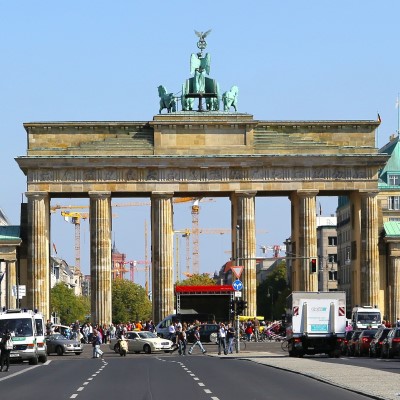 Image by cms-archiv from Pixabay
Image by cms-archiv from Pixabay
With all the building works (and cranes) around the Brandenburg Gate, it's hard to believe the Wall and no man's land had ever isolated it.
My "disconnection from the past" grew stronger during our visit to the former East Berlin. For a start, we only found fragments of the Wall. (One section looked like a recent addition by Nissan to protect a car showroom.) And then there were the "missing" Trabants. We saw less than half a dozen of them all day. By contrast, in 1987, the Ostberlin streets were full of them.
Friedrichstraße leading to Checkpoint Charlie has become one long construction zone. And all that remains of the old border crossing checkpoint is an isolated observation box resembling a derelict British Rail signal box.
The rows of socialist-style tower blocks were there, but instead of Trabants, the apartment car parks were full of VWs, BMWs and Mercs.
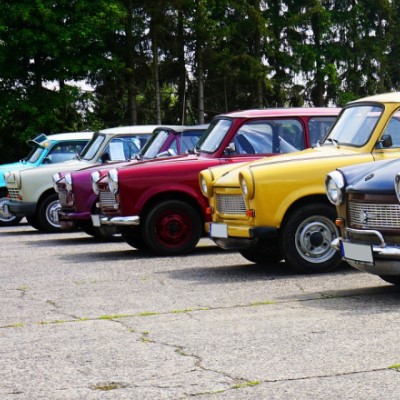 Image by Kira Hoffmann from Pixabay
Image by Kira Hoffmann from Pixabay
The "Big Brother" TV tower still dominates the skyline above Alexanderplatz. And I was pleased to see the beautiful Berliner Dom again. But otherwise, everything else about Berlin had changed from our tourist perspective.
I tried recapturing something of the atmosphere of 1987 with a stein of beer at a canalside cafe overlooking the Berliner Dom. The beer cost 5 Deutsch Marks (instead of 1.5 Ostmarks) and was warm — a fitting end to our fleeting visit.
Brief Backpacker Visits
In the introduction to another Tall And True travel piece, Three Visits to Dahab (Egypt), I asked:
Is it wrong to want our favourite places to stay the same? Probably. It's been over twenty years since I last visited Dahab. I've read tourists still flock there from all over the world. But aspects of Dahab's villages and surroundings must have changed beyond recognition for this "old-timer".
My wife and I only made brief backpacker visits to Berlin in 1987 and 1995. Our focal point both times was the Berlin Wall. I had felt a frisson of excitement crossing Checkpoint Charlie in 1987. But I was disappointed to find little sign of the Wall in 1995. And when our train left Berlin for Prague that evening, I knew I wouldn't be returning for a third visit.
Frederick Taylor and Helena Merriman's books reminded me of the Berlin Wall's place in my consciousness as a boy, even growing up in distant Perth, Western Australia. And as I've mentioned, to cross into East Berlin and back again with five Ostmarks hidden in my moneybelt in 1987 felt like I was living pages from John le Carré's, The Spy Who Came in from the Cold.
I saw the fall of the Berlin Wall and East Germany from relatively close quarters in England in 1989 (compared to viewing it from Australia). And I visited a reunified Berlin in 1995, still undergoing a massive transformation, which has likely made it even more unrecognisable from my memories and journal entries.
The Spanish-American philosopher and novelist George Santayana observed, "Those who cannot remember the past are condemned to repeat it." And yet, I understand why Germans, particularly Berliners, would want to erase their divided past.
© 2021, 2023 Robert Fairhead
With thanks to Photoholiday from Pixabay for sharing the Berliner Mauer photo.
N.B. You might like to read another of my Tall And True travel pieces, Seven Nights in Moscow and St. Petersburg.
Robert is a writer and editor at Tall And True and blogs on his eponymous website, RobertFairhead.com. He also writes and narrates episodes for the Tall And True Short Reads storytelling podcast, featuring his short stories, blog posts and other writing from Tall And True.
Robert's book reviews and other writing have appeared in print and online media. In 2020, he published his début collection of short stories, Both Sides of the Story. In 2021, Robert published his first twelve short stories for the Furious Fiction writing competition, Twelve Furious Months, and in 2022, his second collection of Furious Fictions, Twelve More Furious Months. And in 2023, he published an anthology of his microfiction, Tall And True Microfiction.
Besides writing, Robert's favourite pastimes include reading, watching Aussie Rules football with his son and walking his dog.
He has also enjoyed a one-night stand as a stand-up comic.

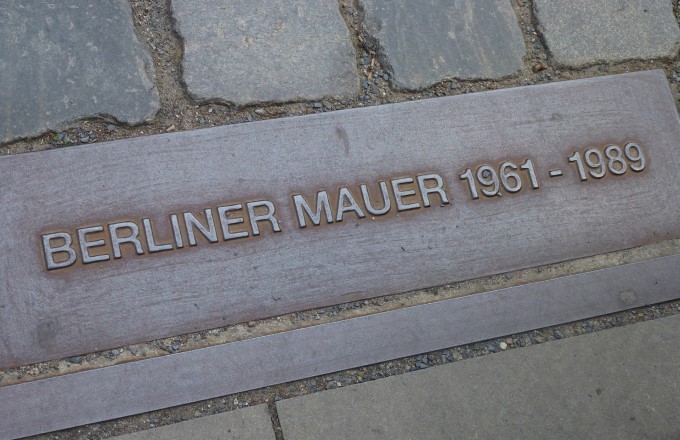
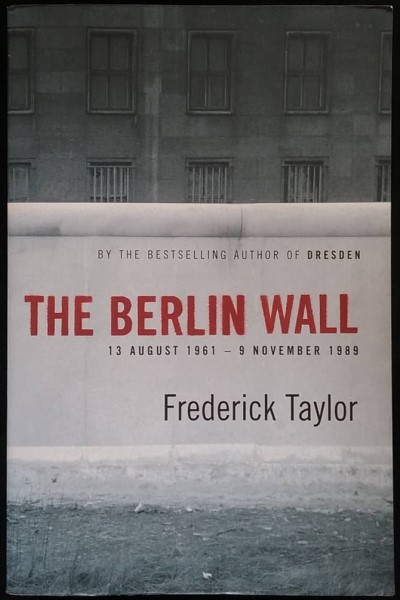 Browse & Buy on Amazon.com.au
Browse & Buy on Amazon.com.au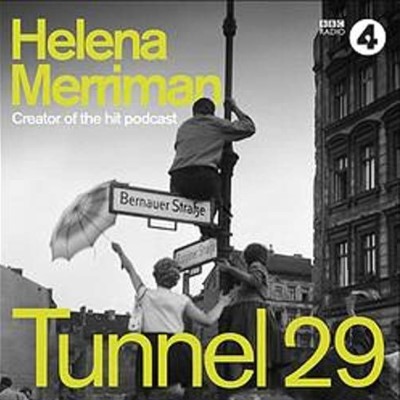 Browse & Buy on Amazon.com.au
Browse & Buy on Amazon.com.au
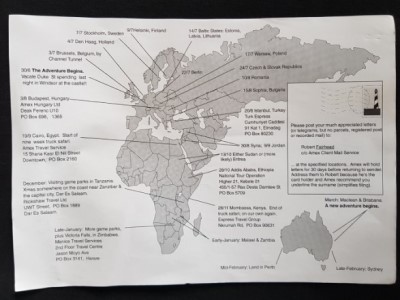
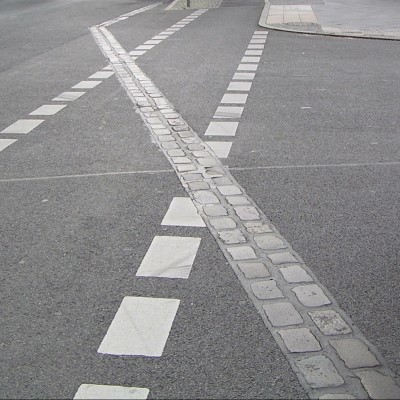 Image by
Image by 